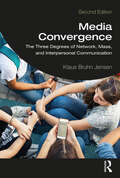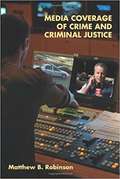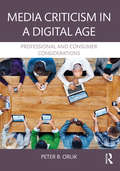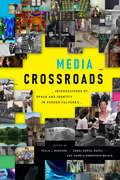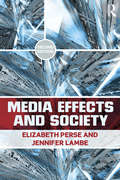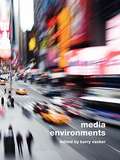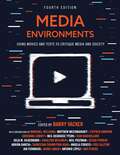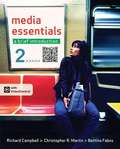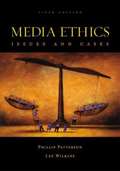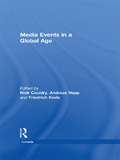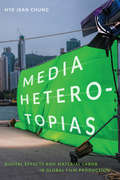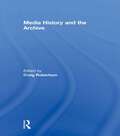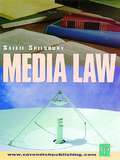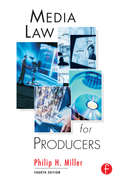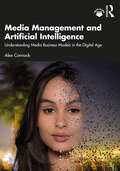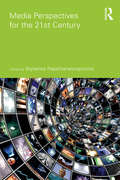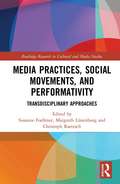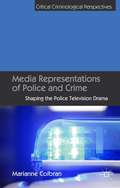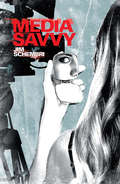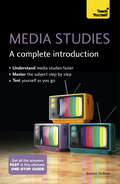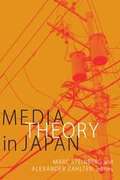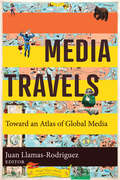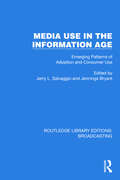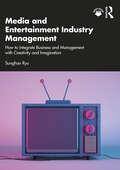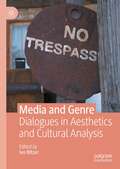- Table View
- List View
Media Convergence: The Three Degrees of Network, Mass, and Interpersonal Communication
by Klaus Bruhn JensenThis second edition furthers conversations about the ongoing society-wide and worldwide digitalization of human communication. Reviewing the long lines in the history of media and communication – from writing via printing and broadcasting to computing – the book lays out three general types of media: the human body enabling face-to-face communication here and now; the technically reproduced means of mass communication across space and time; and the digital technologies integrating one-to-one, one-to-many, as well as many-to-many interactions. All these communicative practices coexist in contemporary media environments. Across cultures, genders, and age groups, people go on communicating in the flesh, via wires, and over the air, as illustrated though case studies of mobile communication on mundane matters, and of climate change as a global challenge for human communication and coexistence. The second edition includes: Updated accounts of research and public debate on digital media and communication Analyses of current social media and an emerging internet of things Systematic presentations of digital as well as traditional empirical methods Discussion of the normative implications of digitalization, including the classic rights of information and communication, and a right not to be communicated about through surveillance Interdisciplinary in scope to showcase the wide-reaching cultural consequences of media convergence, this book is ideal for advanced undergraduate students, graduate students, and scholars in the fields of media, communication, and cultural studies.
Media Coverage of Crime and Criminal Justice
by Matthew RobinsonMedia Coverage of Crime and Criminal Justice critically examines the media to identify how crime and criminal justice are treated in the news and entertainment media. The goal is not only to help shed light on important realities of crime and criminal justice in the United States but also to correct major misconceptions created by coverage of crime and criminal justice in the news, on television, in movies, in music, and other media forms. While there are other texts on the market focused on the impact of mass media on criminal justice, this text is the only one that starts with the issue of corporate ownership of the mass media as a potential problem for gaining an accurate understanding of the realities of crime and criminal justice. Further, this text presents basic information about the media in the introductory chapters and then applies this information to specific issues of crime and criminal justice in the rest of the book, thereby focusing on the same issues and themes throughout the book. Topics analyzed include how the media are organized, how they operate, and to what degree citizens are exposed to the media. Additionally, the book analyzes competing explanations of media coverage of crime and criminal justice, using examples from the real world to show why the media cover topics (and ignore others) the way they do. The book deals with media coverage of law-making and crime, policing, courts, and corrections. There are separate chapters of media coverage of each branch of criminal justice, with reviews of the literature focused on the most recent and influential research on these topics. The book also examines how the media both help and hinder effective crime control and crime prevention efforts. The book concludes with a summary of the book as well as suggestions for media reform, based on major findings of the book.
Media Criticism in a Digital Age: Professional And Consumer Considerations
by Peter B. OrlikMedia Criticism in a Digital Age introduces readers to a variety of critical approaches to audio and video discourse on radio, television and the Internet. It is intended for those preparing for electronic media careers as well as for anyone seeking to enhance their media literacy. This book takes the unequivocal view that the material heard and seen over digital media is worthy of serious consideration. Media Criticism in a Digital Age applies key aesthetic, sociological, philosophical, psychological, structural and economic principles to arrive at a comprehensive evaluation of programming and advertising content. It offers a rich blend of insights from both industry and academic authorities. These insights range from the observations of Plato and Aristotle to the research that motivates twenty-first century marketing and advertising. Key features of the book are comprised of: multiple video examples including commercials, cartoons and custom graphics to illustrate core critical concepts; chapters reflecting today’s media world, including coverage of broadband and social media issues; fifty perceptive critiques penned by a variety of widely respected media observers and; a supplementary website for professors that provides suggested exercises to accompany each chapter (www.routledge .com/cw/orlik) Media Criticism in a Digital Age equips emerging media professionals as well as perceptive consumers with the evaluative tools to maximize their media understanding and enjoyment.
Media Crossroads: Intersections of Space and Identity in Screen Cultures
by Paula J. Massood, Angel Daniel Matos, and Pamela Robertson WojcikThe contributors to Media Crossroads examine space and place in media as they intersect with sexuality, race, ethnicity, age, class, and ability. Considering a wide range of film, television, video games, and other media, the authors show how spaces—from the large and fantastical to the intimate and virtual—are shaped by the social interactions and intersections staged within them. The highly teachable essays include analyses of media representations of urban life and gentrification, the ways video games allow users to adopt an experiential understanding of space, the intersection of the regulation of bodies and spaces, and how style and aesthetics can influence intersectional thinking. Whether interrogating the construction of Portland as a white utopia in Portlandia or the link between queerness and the spatial design and gaming mechanics in the Legend of Zelda video game series, the contributors deepen understanding of screen cultures in ways that redefine conversations around space studies in film and media.Contributors. Amy Corbin, Desirée J. Garcia, Joshua Glick, Noelle Griffis, Malini Guha, Ina Rae Hark, Peter C. Kunze, Paula J. Massood, Angel Daniel Matos, Nicole Erin Morse, Elizabeth Patton, Matthew Thomas Payne, Merrill Schleier, Jacqueline Sheean, Sarah Louise Smyth, Erica Stein, Kirsten Moana Thompson, John Vanderhoef, Pamela Robertson Wojcik
Media Effects and Society (Routledge Communication Series)
by Elizabeth M. Perse Jennifer LambeGrounded in theoretical principle, Media Effects and Society help students make the connection between mass media and the impact it has on society as a whole. The text also explores how the relationship individuals have with media is created, therefore helping them alleviate its harmful effects and enhance the positive ones. The range of media effects addressed herein includes news diffusion, learning from the mass media, socialization of children and adolescents, influences on public opinion and voting, and violent and sexually explicit media content. The text examines relevant research done in these areas and discusses it in a thorough and accessible manner. It also presents a variety of theoretical approaches to understanding media effects, including psychological and content-based theories. In addition, it demonstrates how theories can guide future research into the effects of newer mass communication technologies. The second edition includes a new chapter on effects of entertainment, as well as text boxes with examples for each chapter, discussion of new technology effects integrated throughout the chapters, expanded pedagogy, and updates to the theory and research in the text. These features enhance the already in-depth analysis Media Effects and Society provides.
Media Environments
by Barry VackerMedia Environments is based on a simple concept: combine movies with texts to critique media and society in the 21st century. That's right, movies and texts. But this is not edutainment! This anthology uses popular film as a gateway to critical readings, culled from the works of a variety of well-known thinkers, scholars, and writers. Authors include Stephen Hawking, Al Gore, Naomi Klein, Carl Sagan, Naomi Wolf, Susan Jacoby, Neil Postman, Henry Jenkins, Neil deGrasse Tyson, Ray Kurzweil, and many others. Their writings are introduced to students through films like The Social Network, Contact, Network, American Beauty, Fight Club, The Truman Show, Slumdog Millionaire, Waking Life,WALL. E, Good Night, and Good Luck, and many others.
Media Environments: Using Movies and Texts to Critique Media and Society
by Barry VackerMedia Environments: Using Movies and Texts to Critique Media and Society uses popular film as a gateway to critical readings, encouraging students to think creatively and critically about media, society, technology, and popular culture. <P><P>The text explores media in their totality and provides models and theories for interrogating many universal themes that span media, technology, and planetary civilization. Using popular films about media as lead-ins, students are introduced to the works of well-known thinkers and writers such as Marshall McLuhan, Charlton D. McIlwain, Shoshanna Zuboff, Julia Hildebrand, Neil deGrasse Tyson, Devon Powers, Antonio Lopez, and many others.
Media Essentials: A Brief Introduction (Second Edition)
by Richard Campbell Christopher Martin Bettina FabosMedia Essentials focuses on the fundamentals of mass communication, helping students keep pace with today's rapidly evolving and converging media. Best-selling authors Richard Campbell, Christopher R. Martin, and Bettina Fabos distill the essential information on media industries and major concepts, incorporate their accessible critical approach, and give students all the study tools they need to succeed in the course and be savvy media consumers. For the second edition of Media Essentials, the authors have added and enriched coverage of media topics instructors asked for, including videogames, convergence, media literacy, streaming music, online journalism, and more. This all comes together in a brief, attractive format -- for a very attractive price, about 50% less than competing texts.
Media Ethics: Issues and Cases, 5th Edition
by Philip Patterson Lee WilkinsBy combining real-life and hypothetical cases with a succinct introduction to ethical theory, this text helps students prepare for the ethical situations they will encounter in the media professions. It is an ideal choice as the main text in a media ethics course or as a supplemental text in any course in journalism. The new edition reflects changes in the world post 9/11, including the war in Iraq, the Enron and WorldCom scandals, and a new look at media and democracy in light of FCC-approved media consolidation.
Media Events in a Global Age (Comedia)
by Andreas Hepp Nick Couldry Friedrich Krotz"This volume assembles an estimable range of critical analyses of one of the most important mediated artifacts of the modern world—the media event. The authors challenge the construct, extend its usefulness, expand its theoretical basis and application, and examine media events in a far larger and richer context than ever before. Students of global media today are well served by this superb collection of essays."David Morgan, Duke University, USA "A welcome and worthy successor to Dayan and Katz’s path-breaking study that expands and enriches the discourse on global media events." Daya Thussu, University of Westminster, UK "This is an excellent collection, that will enable new kinds of argument about, and hopefully research into, the spectacular functions of the contemporary media." Graeme Turner, University of Queensland, Australia We live in an age where the media is intensely global and profoundly changed by digitalization. Not only do many media events have audiences who access them online, but additionally digital media flows are generating new ways in which media events can emerge. In times of increasingly differentiated media technologies and fragmented media landscapes, the ‘eventization’ of the media is increasingly important for the marketing and everyday appreciation of popular media texts. The events covered include Celebrity Big Brother, 9/11, the Iraq war and World Youth Day 2005 to give readers an understanding of the major debates in this increasingly high-profile area of media and cultural research.
Media Heterotopias: Digital Effects and Material Labor in Global Film Production
by Hye Jean ChungIn Media Heterotopias Hye Jean Chung challenges the widespread tendency among audiences and critics to disregard the material conditions of digital film production. Drawing on interviews with directors, producers, special effects supervisors, and other film industry workers, Chung traces how the rhetorical and visual emphasis on seamlessness masks the social, political, and economic realities of global filmmaking and digital labor. In films such as Avatar (2009), Interstellar (2014), and The Host (2006)—which combine live action footage with CGI to create new hybrid environments—filmmaking techniques and "seamless" digital effects allow the globally dispersed labor involved to go unnoticed by audiences. Chung adapts Foucault's notion of heterotopic spaces to foreground this labor and to theorize cinematic space as a textured, multilayered assemblage in which filmmaking occurs in transnational collaborations that depend upon the global movement of bodies, resources, images, and commodities. Acknowledging cinema's increasingly digitized and globalized workflow, Chung reconnects digitally constructed and composited imagery with the reality of production spaces and laboring bodies to highlight the political, social, ethical, and aesthetic stakes in recognizing the materiality of collaborative filmmaking.
Media History and the Archive
by Craig RobertsonBy the time readers encounter academic history in the form of books and articles, all that tends to be left of an author’s direct experience with archives is pages of endnotes. Whether intentionally or not, archives have until recently been largely thought of as discrete collections of documents, perhaps not neutral but rarely considered to be historical actors.This book brings together top media scholars to rethink the role of the archive and historical record from the perspective of writing media history. Exploring the concept of the archive forces a reconsideration of what counts as historical evidence. In this analysis the archive becomes a concept that allows the authors to think about the acts of classifying, collecting, storing, and interpreting the sources used in historical research. The essays included in this volume, from Susan Douglas, Lisa Gitelman, John Nerone, Jeremy Packer, Paddy Scannell, Lynn Spigel, and Jonathan Sterne, focus on both the theoretical and practical ways in which the archive has affected how media is thought about as an object for historical analysis.This book was published as a special issue of The Communication Review.
Media Law
by Sallie SpilsburyThe aim of this book is to analyse media law in relation to specific areas,both in terms of its practical application and its theoretical framework. Part 1 concentrates on the regulation of media content and is largely written from a pro media point of view. Its central tenet is how far does the English media enjoy freedom of expression and the way in which that impacts on how the media operates. It considers how the Human Rights Act 1998 impacts on the media. Part 2 moves on to look at the regulation of the media industries as a whole. Part 3 focuses on day to day transactions for the media. In particular it focuses on provisions from typical media agreements and aims to provide a context for the law which has been outlined in Parts 1 and 2. The structure of this book bridges the gap between a traditional textbook and practitioner work and provides a book which will be of interest to law degree and LPC students and practitioners.
Media Law for Producers
by Philip MillerMedia Law for Producers is a comprehensive handbook that explains, in lay terms, the myriad legal issues that the producer will face on a regular basis - contracts, permits, defamation, patents, releases and insurance, libel, royalties and residuals, as well as protecting the finished production. This revised and expanded edition includes such Internet-related topics as Internet music law, online registration, and online privacy. Other new topics covered include:· Implied and express contracts in the project/idea submission process · Assignment/transfer of copyright· Music clip licensing· Use of other people's trademarks in media production· Parody as a defense to copyright infringement Clear explanations examine the how and why of different types of production contracts, and checklists provide a quick means for producers to determine when their productions might be at greatest risk to legal challenges. Media Law for Producers also examines the substantial changes in copyright term resulting from recent copyright legislation. Legal problems can be very costly to media producers. Lawyers and court fees, coupled with the loss of work time, can lead to bankruptcy. Media Law for Producers cuts through the legalese and illustrates legal issues to help producers recognize the legal questions that can arise during production.
Media Management and Artificial Intelligence: Understanding Media Business Models in the Digital Age
by Alex ConnockThis cutting-edge textbook examines contemporary media business models in the context of Artificial Intelligence (AI) and digital transformation. AI has dramatically impacted media production and distribution, from recommendation engines to synthetic humans, from video-to-text tools to natural language models. "AI is really the change agent of the media industry," answered a natural language generation model when AI was ‘asked’ about the subject of this book. "It will open incredible opportunities." This book seeks to explore them. The media is examined through four sections. ‘Principles’ maps business models and the key tools of AI. ‘Platforms’ covers distribution channels in Games, Streamers, Social Networks, Broadcast and Digital Publishing. ‘Producers’ covers the engines of content-making, including Scripted, Entertainment, Factual, Content Marketing, Creators and Music. Finally, ‘Pioneers’ covers emerging sectors of Podcasting, Esports, the Metaverse and other AI-driven developments. Then in each chapter, a standard value creation model is applied, mapping a single sector through development, production, distribution and monetisation. Diverse case studies are analysed from India, Nigeria, South Korea, South Africa, France, the Netherlands, the US, the UK, Denmark and China – around creative entrepreneurship, revenue models, profit drivers, rights and emerging AI tools. Questions are provided for each case, whilst chapter summaries cement learning. Applied and technology-focused, this text offers core reading for advanced undergraduate and postgraduates studying Media Management – or the relationship between Entertainment, Media and Technology. Online resources include chapter-by-chapter PowerPoint slides and an Instructor’s Manual with further exercises and case studies.
Media Perspectives for the 21st Century (Communication and Society)
by Stylianos PapathanassopoulosMedia Perspectives for the 21st Century brings together key international scholars to explore concepts, topics and issues concerning the communication environment in contemporary democratic societies. It combines qualitative and quantitative approaches to provide an interdisciplinary and truly global perspective that reflects the trends, theories and issues in current media and communication research. The collection raises significant questions about the study of the media by challenging approaches to major media and societal issues, and analyses in more depth the range of concerns that shape both the present and the future media landscape and the issues these can create for communication. It also investigates the main effects of technological developments on the domain of the news media and journalism. Divided into two main sections, Part I provides accounts of the role of the media in society, and deals with agendas that affect the field of communications studies. Part II goes on to examine the world of new media and offers analyses on the developments of the 21st century. Chapters deal with various dimensions of media from a number of different perspectives and socio-political contexts, covering a wide range of topics including Social Networking, Political Communication, Public Journalism, Global Infotainment and Consumer Culture. Media Perspectives for the 21st Century will be highly useful to undergraduate and postgraduate students, as well as researchers and academics, in the fields of media and communication studies, mass communication, journalism and new media.
Media Practices, Social Movements, and Performativity: Transdisciplinary Approaches (Routledge Research in Cultural and Media Studies)
by Margreth Lünenborg Susanne Foellmer Christoph RaetzschAs individuals incorporate new forms of media into their daily routines, these media transform individuals’ engagement with networks of heterogeneous actors. Using the concept of media practices, this volume looks at processes of social and political transformation in diverse regions of the world to argue that media change and social change converge on a redefinition of the relations of individuals to larger collective bodies. To this end, contributors examine new collective actors emerging in the public arena through digital media or established actors adjusting to a diversified communication environment. The book offers an important contribution to a vibrant, transdisciplinary, and international field of research emerging at the intersections of communication, performance and social movement studies.
Media Representations of Police and Crime
by Marianne ColbranThis unique book explores the social processes which shape fictional representations of police and crime in television dramas. Exploring ten leading British and European police dramas from the last twenty-five years, Colbran, a former scriptwriter, presents a revealing insight into police dramas, informed by media and criminological theory.
Media Savvy
by Jim SchembriWhile on work experience with a TV news crew, 16 year-old Cobey Miles suddenly finds herself in front of the camera covering a breaking news story about two bodies being uncovered in the ice. She proves an instant hit and her burgeoning modelling career starts to skyrocket. But when she sniffs something fishy behind the scenes at the station, Cobey realises that the story she has to tell is something certain people do not want to hear. Cobey is ultimately faced with a hard choice: leave the story alone and seize upon the success she is enjoying, or reveal the truth and risk consequences that may endanger her career ? or her life. From the acclaimed author of MURDER IN AISLE 9, WELCOME TO MINUTE 16 and THE EIGHT LIVES OF STULLIE THE GREAT, Jim Schembri once again scripts a fast-paced and edgy novel, laced with humorous writing.
Media Studies: A Complete Introduction: Teach Yourself
by Joanne HollowsWritten by an academic and researcher with over twenty years' experience in teaching and convening Media Studies courses, Media Studies: A Complete Introduction is designed to give you everything you need to succeed, all in one place. It covers the key areas that students are expected to be confident in, outlining the basics in clear jargon-free English, and then providing added-value features like case studies, and even lists of questions you might be asked in your seminar or exam.The book uses a structure that mirrors the way Media Studies is taught on many university courses. Chapters include essential coverage of the history, organization and production of the media industries, and regulation of the media. The analysis of media texts is covered in detail, as are the issues of identity and gender, the idea of globalization and the shifting face of social media in its many contexts.
Media Theory in Japan
by Alexander Zahlten Marc SteinbergProviding an overview of Japanese media theory from the 1910s to the present, this volume introduces English-language readers to Japan's rich body of theoretical and conceptual work on media for the first time. The essays address a wide range of topics, including the work of foundational Japanese thinkers; Japanese theories of mediation and the philosophy of media; the connections between early Japanese television and consumer culture; and architecture's intersection with communications theory. Tracing the theoretical frameworks and paradigms that stem from Japan's media ecology, the contributors decenter Eurocentric media theory and demonstrate the value of the Japanese context to reassessing the parameters and definition of media theory itself. Taken together, these interdisciplinary essays expand media theory to encompass philosophy, feminist critique, literary theory, marketing discourse, and art; provide a counterbalance to the persisting universalist impulse of media studies; and emphasize the need to consider media theory situationally. Contributors. Yuriko Furuhata, Aaron Gerow, Mark Hansen, Marilyn Ivy, Takeshi Kadobayashi, Keisuke Kitano, Akihiro Kitada, Thomas Looser, Anne McKnight, Ryoko Misono, Akira Mizuta Lippit, Fabian Schäfer, Marc Steinberg, Tomiko Yoda, Alexander Zahlten
Media Travels: Toward an Atlas of Global Media
by Juan Llamas-RodriguezMedia Travels: Toward An Atlas of Global Media fills a significant gap in global media scholarship by offering short, readable articles covering different types of media from around the world. Through careful and informed analysis, these eleven accessibly written chapters illustrate the particularities of different media practices and situate them within social, historical, and geographical contexts. Examples range from South African video games to Korean TV series popular in Latin America to Indigenous film and media from the US and Canada. Media studies courses, particularly introductory courses, are often narrowly focused on US and Western European canons. Instructors for introductory media studies courses wishing to expand the offerings in their curricula will find in these essays new ways of approaching foundational concepts and issues in the field, including globalization, social difference, and diverse media cultures. Scholars wishing to expand their research into specific media forms or representational issues can also turn to these case studies for approaches from beyond the US. By including a variety of media and several geographical areas, the collection introduces readers to the formal, technological, and cultural diversity of global media studies. Edited by Juan Llamas-Rodriguez with contributions from Anthony Adah and Añulika Agina, Maria Corrigan, Benjamin Han, Anna Shah Hoque, Meryem Kamil, Angelica Marie Lawson, Lilia Adriana Perez Limon, Sonia Robles, Kuhu Tanvir, David Tenorio, and Rachel van der Merwe.
Media Use in the Information Age: Emerging Patterns of Adoption and Consumer Use (Routledge Library Editions: Broadcasting #27)
by Jerry L. SalvaggioMedia Use in the Information Age (1989) analyses new technologies, their impact on mass communications, and their effects on the users of these new systems. It looks at technologies such as videotex, and their successes and failures around the world, and examines the early adoptions of technologies such as home computers.
Media and Entertainment Industry Management: How to Integrate Business and Management with Creativity and Imagination
by Sunghan RyuThe media and entertainment industry (MEI) differs significantly from traditional industries in many respects. Accordingly, the management of strategy, marketing and other business practices in the MEI necessitates a unique approach. Sunghan Ryu offers students focused and relevant insights into critical topics, illustrated by vivid examples from the MEI. Unlike typical introductory textbooks on business and management, this book does not overemphasize complicated layers of theory. Instead, it presents essential concepts and frameworks in a digestible manner and supplements them with opportunities to apply this knowledge to real-world cases. The textbook demonstrates how knowledge can be constructively implemented in business and management scenarios. It is structured into 12 chapters, divided into five core modules: (1) Overview of the MEI, (2) The Fundamentals of Management, (3) Marketing Management, (4) Digital Business and Management, and (5) New Business Models and Entrepreneurship. Students will gain the ability to explain key concepts and frameworks across core business and management domains and develop analytical skills through diverse real-world cases in the MEI. Based on this knowledge, they will be equipped to identify management-related issues in the MEI and arrive at practical and effective solutions.This book is an essential guide for students who wish to understand business and management in the dynamic world of the MEI.
Media and Genre: Dialogues in Aesthetics and Cultural Analysis
by Ivo RitzerThis book reflects and analyzes the relationship between media and genre, focusing on both aesthetics and discursive meaning. It considers genres as having a decisive impact on media cultures, either in film, on TV, in computer games, comics or radio, on the level of production as well as reception. The book discusses the role of genres in media and cultural theory as a configuration of media artifacts that share specific aesthetic characteristics. It also reflects genre as a concept of categorization of media artifacts with which the latter can be analyzed under terms depending on a specific historical situation or cultural context. A special focus is placed on trans-media perspectives. Even as genres develop their own traditions within one medium, they reach beyond a media-specific horizon, necessitating a double perspective that considers the distinct recourse to genre within a medium as well as the trans-media circulation and adaption of genres.
